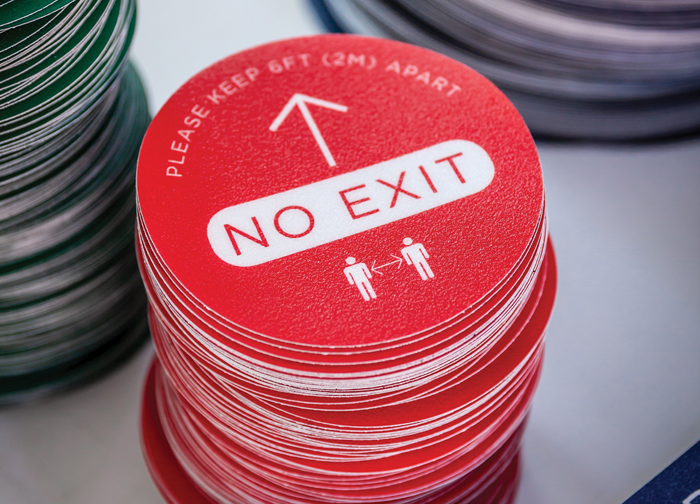Pushing the Boundaries of Protection
Zach Norris
Historically, the designer in me would grapple with an over-abundance of notices, floor decals, placards, stanchions, signage and barriers (as helpful and necessary as they may be). But, the truth of the matter is that they are all necessary in this post-COVID world (that and the fact that yes, I work in the signage industry).
As manufacturers of signage and PPE, one of our advantages at Bourne Group is material sourcing and availability.

A majority of the material used to manufacture our custom-signage is also used for the manufacturing and production of protective barriers and screens.
At the onset of the pandemic, Bourne Group was able to quickly pivot to producing and supplying face shields, protective barriers and prohibitive signage to our local hospitals, medical offices, schools, and cruise
lines. Necessary products with a utilitarian approach, used for protection, simple business transactions, or on desktops with students seated safely behind. Now that we have some light at the end of the COVID tunnel and cruise chatter has been at the forefront we are faced with how to bridge the need for protection with a focus on design aesthetic for minimal passenger interference.
Bridging this need for the cruise market will take more of a collaborative approach due to the impact on the guest experience. That’s why, now, more than ever, the need for integrated barriers in key areas onboard is critical. We want passengers to be assured they are safe, but we don’t want to make them feel that the crew is inaccessible. We want to encourage freedom to explore onboard, but want to eliminate congregating. Case in point, the Atrium. The open, grand, opulent meeting point that serves as
the amuse-bouche to your journey. Can this element, central to the cruise experience, be covered in sheets of rectangular plexiglass suspended by fishing line? Or can we push the boundaries of protection? What are the options to integrate these temporary structures into the existing decor so they are both obvious and invisible?
So the question remains: Can we bridge the aesthetic with the practical? The fashion with the function? The design with the utility? Obviously, this is always the desired achievement with any newbuild or refurbishment project, but the very nature of protective fixtures lends itself to limited options that have a very clinical function. But the short answer is, yes. There are areas onboard that will need custom fixtures to maintain the magical appeal of the voyage. And, there are areas onboard that will require a simple plexiglass screen.
We know the new world of cruising will be littered with protective screens and barriers — as experts in the manufacturing realm, our duty is to continue to ask these questions and seek out the relationships to deliver environments for the industry with a focus on the guest experience and overall protection of passengers and crew onboard.
Originally published in Cruise Industry News: Return to Service, Septemeber 2020.